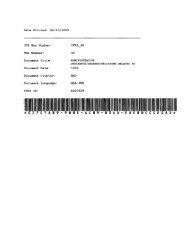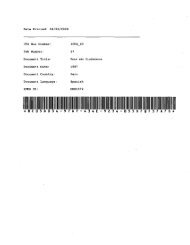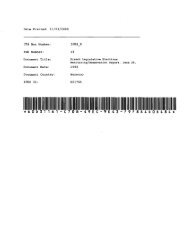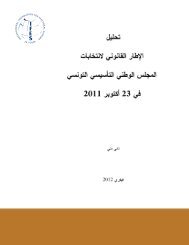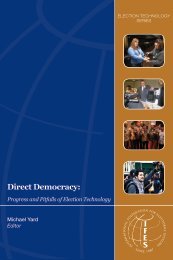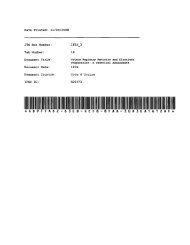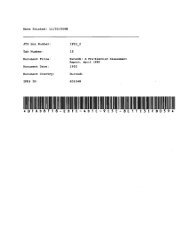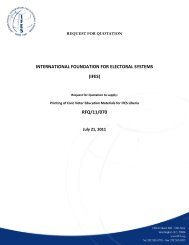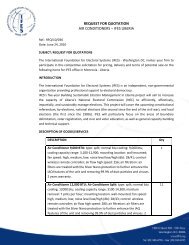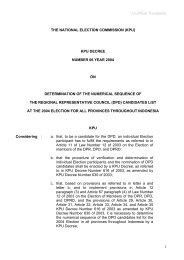Electronic Voting & Counting Technologies - IFES
Electronic Voting & Counting Technologies - IFES
Electronic Voting & Counting Technologies - IFES
- No tags were found...
You also want an ePaper? Increase the reach of your titles
YUMPU automatically turns print PDFs into web optimized ePapers that Google loves.
INTERNATIONAL ELECTORAL PILOT PREREQUISITESSTANDARDSopposed to internet voting replacing votingby mail), then the identification of the voterswho will participate, or have the opportunity toparticipate, in the pilot will be clear. All of thevoters registered to vote at that location, or asubset of this group, will participate in the pilot.It is advisable that electronic voting andcounting technologies be piloted inmultiple locations, so that a cross sectionof the electorate can test the use of theselected technologies. This will requirethat consideration be given to the differentkinds of voters that should be provided theopportunity to test the use of the electronicvoting or counting technologies. For example,only testing electronic voting or countingtechnologies in urban locations would notbe advisable as rural voters may have a verydifferent reaction to using these technologies.It may well also be that there are a range ofenvironmental factors in which electronicvoting and counting technologies need tobe tested, and therefore pilot locations willneed to be selected accordingly. Initial pilotsmay also be chosen for constituencies/areaswhich are not contentious politically so as toavoid politically charged scenarios and allowtrust to build in the pilot technologies. If thesituation permits, a pilot could be conductedfirst in a single location to primarily test theEMB’s ability to cope with the new process,procedures, training, voter education andlogistical requirements. Subsequent pilotscould be conducted at a number of locationsrepresenting a broader variety of the electorate.Piloting remote electronic voting solutions,such as internet voting, may require a differentapproach to selecting pilot participants.The selection of participants for a remoteelectronic voting pilot may be limited by voteridentification mechanisms that the remotevoting system would utilize. Or the remotevoting solution may be targeted at a specificsection of the electorate, such as votersabroad, indicating that this entire groupshould take part in the pilot project.Solutions Being PilotedThe decision in principle may indicate thatone electronic voting or counting solution bestmeets the needs of the electoral process.This does not mean that it has to be the onlysolution piloted. Likewise, if a specific type oftechnology is being piloted (e.g., electroniccounting of scanned ballots), then thisdoes not mean that several other countingsolutions cannot be tested as part of the pilot.The mandate may indicate which specifictechnology is to be piloted and if a rangeof solutions or a single solution is to bepiloted. It is recommended that morethan one electronic voting and countingsolution be piloted. This is important ifthis is the first time these technologies arebeing investigated; allowing for greaterunderstanding of the various systems.Where the solutions to be piloted have notbeen made clear in the mandate, this needsto be determined at the early stage of thepilot project management process.LegislationThe process of taking the decision inprinciple should have identified if the existingelectoral legal framework permits the use ofInternational Foundation for Electoral Systems 53



